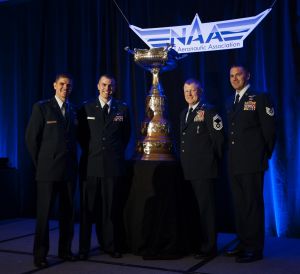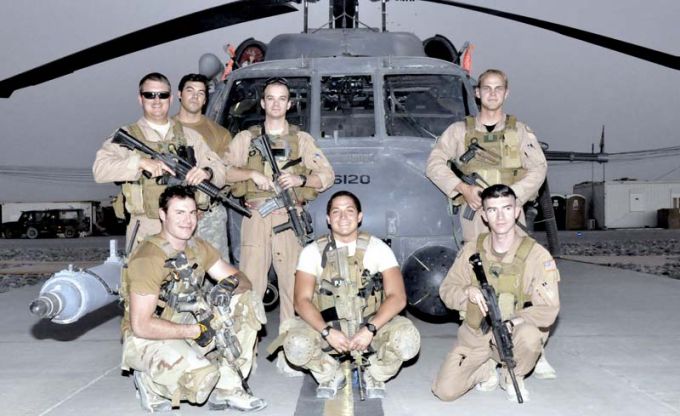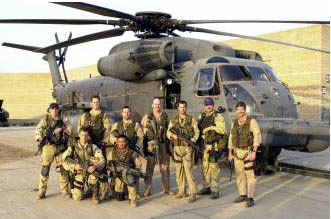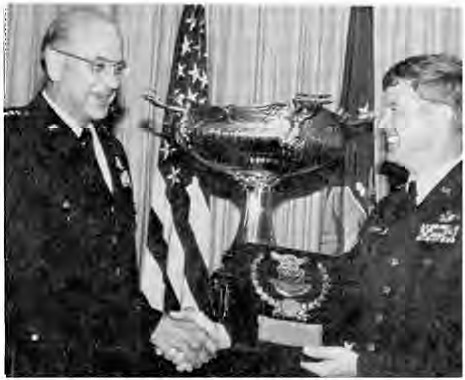
The Mackay Trophy is the oldest aviation award presented and is administered by the United States National Aeronautic Association. It is awarded yearly by the United States Air Force for the "most meritorious flight of the year" by an Air Force person, persons, or organization. The award was created in 1911 by Clarence H. Mackay, a prominent American industrialist, philanthropist and aviation enthusiast and first presented in 1912 and deeded to the National Aeronautic Association. The three-foot tall silver trophy rests on a mahogany base and features four winged figures surrounding the cup, each holding a different pusher-type biplane. Winners' names are engraved onto silver shields affixed to the base. The trophy is now on permanent display at the National Air and Space Museum in Washington, D. C. Each recipient of the Mackay Trophy receives an engraved gold medal to commemorate his achievement.

Listed below are USAF helicopter crews
that have been awarded the coveted trophy
IF YOU KNOW OF OTHERS RECEIVING THIS AWARD ALONG WITH MISSION SPECIFICS, LET US KNOW

2013
41st Rescue Squadron earns MacKay Trophy

Members of Pedro 83 Flight;
L-R, Capt. Vincent Powell, Capt. Brion Stroud, CMSgt. Norman Callahan and TSgt. John Ballard,
accept the Mackay Trophy on behalf of Pedro 83 Flight in a ceremony, in Arlington, Va., Nov. 12, 2013 |
WASHINGTON (AFNS)--
The Response
A team of U.S. Special Forces and Afghan National Army commandos were in day two of an operation to clear a village of enemy forces when the Afghan troop was injured.
Comprised of two HH-60G Pavehawk helicopters and their crews from the 41st Rescue Squadron, Moody Air Force Base, Ga., Pedro Flight 83 arrived at the scene.
One helicopter crew hovered, firing upon the enemy and providing reconnaissance while the second crew, called Chalk 2, descended into the riverbed below.
“One thing different about this mission was since we were at the bottom of a river valley all the engagements were going on above us,” said Capt. Brian Stroud, the co-pilot of Chalk 2. “It is a different feeling looking up through the rotor disc, realizing that if we were engaged we were completely helpless.”
Chalk 2 identified a small, open area in the riverbed where they could land and provide a quick evacuation of the patient.
Now on the ground, pararescuemen sped to the wounded Afghan and used their expert skills to stabilize the patient and move him quickly back to the waiting Pavehawk.
The crew evacuated under the protection of the helicopter above, transported the wounded troop to a medical team within the "golden hour," and he survived.
The golden hour refers to a standard that gets troops to advanced-level treatment facilities within the first critical 60 minutes of being wounded.
The Trophy
In honor of these heroic acts, Lt. Gen. Stephen Hoog, the Air Force assistant vice chief of staff, presented the Mackay Trophy to Pedro 83 Flight on behalf of the National Aeronautic Association.
The trophy is awarded for the "most meritorious flight of the year," according to the NAA, by an Air Force person, persons, or organization.
“I never imagined I would be associated with winning the Mackay trophy, an award of this caliber,” said Tech. Sgt. John Ballard, an aerial gunner onboard chalk 2. “This team of professionals really carries forth the mentality to ensure these men and women make it home.”
First presented by Clarence Mackay in 1912 and later deeded to the NAA, the trophy has been awarded to individuals, including 2nd Lt. Henry H. ’Hap’ Arnold in 1912 and Capt. Chuck Yeager in 1947.
“I am honored to be a part of this ceremony that honors the men and women who bravely display airpower strength,” Hoog said. “I have no doubt that the pioneers (who came) before us are honored these Airmen are receiving the Mackay Trophy.”
“The men and women of Pedro 83 Flight are just ordinary men and women, but are doing extraordinary things in the service of our nation,” said Hoog. “To them this type of heroic mission is just another day on the job. Their slogan says it all, ‘So Others May Live.’”

2011
THE CREWS OF PEDRO 83 FLIGHT who distinguished themselves in combat search and rescue operations on April 23, 2011 while assigned to the 83rd Expeditionary Rescue Squadron, Bagram Air Base, Afghanistan.
Crew Members of Pedro 83
Captain Joshua Hallada (Flight Lead)
First Lieutenant Elliot Milliken (Co-Pilot)
Senior Airman Michael Price (Flight Engineer)
Senior Airman Justin Tite (Aerial Gunner)
Crew Members of Pedro 84
Major Philip Bryant (Mission Pilot)
Captain Louis Nolting
Technical Sergeant James Davis
Technical Sergeant Heath Culbertson
Technical Sergeant William Gonzalez
Crew Members of Guardian Angel Team
Major Jesse Peterson (Guardian Angel Team Commander)
First Lieutenant Aaron Hunter (Combat Rescue Officer)
Master Sergeant Matthew Schrader (Pararescueman)
Technical Sergeant Joshua Vanderbrink
Technical Sergeant Christopher Uriarte
Technical Sergeant Shane Hargis
Staff Sergeant Jason Ruiz
Staff Sergeant Angel Santana
Staff Sergeant Nathan Greene
Staff Sergeant Zachary Kline
Staff Sergeant William Cenna

2009
AirForceTimes
By Brian Kalish - Staff writer
Posted: Tuesday Jun 1, 2010 15:41:26 EDT
33rd Rescue Squadron earns MacKay Trophy
Four airmen from the 33rd Rescue Squadron at Kadena AB, Japan, Capt. Robert Rosebrough, 1st Lt. Lucas Will, MSgt. Dustin Thomas and SSgt. Tim Philposst, as crew members of a HH-60G "Pavelow" (Call sign "Pedro 16") have been selected to receive the 2009 MacKay Trophy for saving the crew of a downed Air Force HH-60G "Pavelow" (Call sign "Pedro 15") and three soldiers in Afghanistan.
During a medical evacuation mission, on 29 July 2009, to rescue three wounded soldiers whose convoy was derailed by an improvised explosive device, the crews of two HH-60G Pave Hawk combat search-and-rescue helicopters — "Pedro 15" and "Pedro 16" — came under heavy enemy fire.

| The crew of "Pedro 16" poses in July 2009, at Kandahar Air Field, Afghanistan. Pictured are Capt. Robert Rosebrough (middle, standing), 1st Lt. Lucas Will (right, standing), Master Sgt. Dustin Thomas (far left, standing) and Staff Sgt. Tim Philpott (right, kneeling). The airmen from the 33rd Rescue Squadron, based at Kadena Air Base, Japan, were recently announced as the 2009 MacKay Trophy winners. |
"Pedro 15" was downed, and along with an Army OH-58 Kiowa crew, the "Pedro 16" crew — Capt. Robert Rosebrough, 1st Lt. Lucas Will, Master Sgt. Dustin Thomas and Staff Sgt. Tim Philpott — rescue the wounded soldiers and downed airmen from an active firefight with enemy forces.
The rescue squadron, based at Kadena Air Base, Japan, was also awarded the 2009 Verne Orr Award and was recognized by the Jolly Green Association for most outstanding rescue mission of the year. 

2004
41st Rescue Squadron and 38th Rescue Squadron
Jolly 11
1Lt Bryan Creel
Capt Joseph Galletti
Sgt Thomas Ringheimer
SSgt Vincent J. Eckert
SSgt John Griffin
SSgt Patrick Ledbetter
Jolly 12
Capt Rob Wrinkle
1Lt Gregory Rockwood
TSgt Michael Preston
TSgt Paul Silver
SSgt Matthew Leigh
SSgt Michael Rubio
SrA Edward Ha
Jolly 11 and Jolly 12 crewmembers distinguished themselves by gallantry in connection with rescue operations near Kharbut, Iraq, on April 16, 2004. On this date, in support of Operation IRAQI FREEDOM, Jolly 11 Flight launched to rescue a five person crew of a U.S. Army CH-47 that crashed in a sandstorm with near zero visibility. En route to the crash scene, crews realized their forward looking infra-red and night vision goggles were ineffective. Continuing to use each crewmember to their fullest degree, Jolly 11 Flight was able to locate the survivors. Both aircraft then made near zero visibility approaches relying nearly exclusively on the flight engineers and aerial gunners inputs for precision navigation. Following the successful survivor contacts and recovery by the Flight’s Pararescuemen, Jolly 11 and Jolly 12 were individually engaged by separate multiple surface-to-air missiles attacks. Using evasive maneuvers and working as a fine-tuned, combat seasoned team, Jolly 11 evaded two missiles. Both Jolly 11 and Jolly 12 continued to provide mutual wingman support with defensive fire until the formation was clear of the threat area saving the lives of five U.S. Army personnel. Their gallantry and devotion to duty reflect great credit upon themselves and the United States Air Force.

2001
20th Special Operations Squadron KNIFE 04
For rescuing the crew of a sister ship under extremely hazardous weather conditions behind enemy lines in Afghanistan. The crew of Knife 04 (shown here with their Pave Low MH-53) from the 20thSpecial Operations Squadron, Hurlburt Field, Fla., received the 2001 MacKay Trophy for performing “extraordinary acts of valor and heroism” during the rescue of the crew of another MH-53 stranded behind enemy lines in the mountains of Afghanistan. | 
|
The crew of "Knife 04" consisted of 1st. Lt. Mike Holder, Capt. Jay Humphrey, SSgt. Vince Depersion, SSgt. Chad Ackman, SSgt. Mark Wolcott, SSgt. Al Aguinaldo, SSgt. Paul Orse, SSgt. Bill Adams and Sr. Amn. Jason Andrews.
The crew earned the trophy for a rescue mission involving another crew from the 20th SOS whose helicopter went down during Operation Enduring Freedom. The Air Force-level award is given annually to the Air Force member, crew or organization that makes the most meritorious flight of the year.
According to an official report, both helicopters were en route to rescue a Special Operations member, Nov. 2 when the incident happened. Both Pave Lows launched and within hours crossed into Afghanistan where the aircrews had to make a decision whether or not to continue, based on the bad weather they were encountering.
The terrain’s altitude increased while weather conditions deteriorated, making the flight more dangerous. Because of the worsening conditions, the two helos began an orbit pattern while deciding whether to press on or turn back. They decided to turn back, but while flying out of the poor weather the first helo -- which had lost radar function -- lost visual contact with the second Pave Low. The last known radio transmission from the stranded aircraft was “Standby.” Unbeknownst to the crew, their sister ship was on the ground.
The crew on the ground endured below freezing temperatures for almost five hours, said Staff Sgt. Clint, a gunner on the downed helicopter. Due to operational security reasons, the gunner's last name is not being released. “There is an extreme surge of adrenaline associated with being on the ground behind enemy lines,” said Capt. Frank, the pilot of downed Pave Low.
But the crew took comfort in knowing their sister ship was still in the area. “I knew if anyone could get us out it would be those guys,” said Captain Frank, whose last name is not being released for security reasons.
The crew’s survival, evasion, resistance and escape training kicked in, he added, but the urgency to get out of the freezing temperature increased because several of the crewmembers were injured.
Meanwhile, the airborne Pave Low coordinated with an airborne command and control asset to try to make radio contact with their squadron mates on the ground. “My mind was running a million miles an hour," said Staff Sgt. Alberto, a gunner on the Pave Low circling the area. "(I was) reaching back to all my training, listening to my crew and radios, scanning for threats, looking for escape routes, thinking about evasive maneuvers, all at the same time. What kept repeating in my mind was ‘We are not going to leave our brothers!’”
The crew made several attempts to reach the downed MH-53, each time pushed back because of weather. “The snow clouds blanketed the rugged mountains and valleys,” said Sergeant Alberto. “After several hours of trying to penetrate the weather, the clouds opened up. It was weird – like Moses parting the Red Sea.”
Landing at the site of the downed helicopter became dangerous as blowing snow caused the crew to lose visibility. “Outstanding crew coordination and timely inputs from the scanners allowed (them) to land safely,” said Lt. Col. Michael Kingsley, 20th SOS commander.
With the downed crew now on board their sister helo, the relief set in. “When we got back in the sky I couldn’t stop feeling a burst of happiness,” said Sergeant Alberto.
Because of the altitude and the extra weight, the Pave Low wasn’t able to climb more than a few feet off the ground. “The engines were screaming at maximum power,” said 1st Lt. Mike, pilot of rescue Pave Low. “That was the most tense part of the flight, but the crew was outstanding.” Lieutenant Mike and his crew traded altitude for airspeed when the terrain began to slope. That trade gave them enough power to feel sure they could continue to fly, said the pilot.
With only about 35 minutes of fuel remaining, the crew called in for an aerial refueling. The refueling was risky because they had so little power that they couldn’t take on much fuel. It would take several partial aerial refuelings before the helo would make it to a site to unload the wounded passengers.
“The crewmembers are heroes to me and my crew,” said Captain Frank. The rescue was a team effort, said the lieutenant. “The support we had when things were going badly is incredible,” said Lieutenant Mike. “First, there was the 8th SOS with their ‘Johnny on the Spot’ aerial refueling. Then there were other assets relaying radio messages. Finally, I can’t say enough about (the downed crew) and how they kept cool heads. They developed a plan and greatly improved their chances of rescue. Even though this rescue seemed impossible, they’re the ones who made it happen.”

1998
Guard rescue mission named top 1998 U.S. Air Force flight
Crew of Air Force Rescue 470
Five members of the 210th Rescue Squadron received the Air Force's top honor for meritorious flying for their daring 1998 mountaintop rescue of six people trapped in a crashed airplane.
Gen. Michael Ryan, Air Force chief of staff, presented the 1998 MacKay Trophy to the five-member helicopter crew of Air Force Rescue 470 during a special luncheon in Arlington, Va., Sept. 21. "This was truly an heroic rescue," Ryan said. "Six lives were saved because of the crew's dedication and professionalism."
The crew included Maj. John Jacobs, the pilot; lst Lt. Thaddeus Stolar, the copilot; Master Sgt. Scott Hamilton, the flight engineer; and Master Sgt. Steve Daigle and Tech. Sgt. Greg Hopkins, the pararescuers.
The crew maneuvered their Pave Hawk helicopter through thick, swirling clouds and strong winds May 27, 1998, to rescue the six people trapped in the downed Cessna 207 at the 10,500-foot level of Mount Torbert, about 70 miles west of Anchorage. The survivors, including two children, were lightly dressed and in danger of exposure from the wind chill atop the glacier.
The rescue took nearly seven hours. The helicopter crew spent much of the time battling fierce winds while trying to find an opening in the clouds so it could land near the crash site. Finally, at sunset, the helicopter was able to land on a knoll about 600 feet from the wreckage. Daigle and Hopkins made their way to the crash site, chopped snow away from the only operable door on the overturned Cessna and then guided the passengers over a snow-covered glacier.

1994
Crew of Air Force Rescue 206:
Capt John W. Blumentritt
Capt Gary W. Henderson
SRA Jeffrey M. Frembling
SSGT Matthew A. Wells
SRA Jesse W. Goerz
Crew of Air Force Rescue 208:
Lt Col James A. Sills
Lt Col Gary L. Copsey
Lt Richard E. Assaf
TSgt Gregory M. Reed
SR William R. Payne
For extraordinary heroism and self-sacrifice during the rescue of six Icelandic sailors who were stranded when their ship foundered in heavy seas and strong winds. HH-60G crew of Air Force Rescue 206 and 208, 56th Rescue Sq., ACC, NAS Keflavik, Iceland.

1991
MH-53J Pave Low Crew, 20th Special Operations Squadron. Hurlburt Field, Florida, Air Force Special Operations Command.
Crew of Moccasin 05:
Capt Thomas J. Trask
Maj Michael Homan
MSgt Timothy B. Hadrych
Tech Sgt Gregory Vanhyning
Tech Sgt James A. Peterson, Jr.
SSgt Craig Dock
Sgt Thomas W. Bedard
For extraordinary heroism and self-sacrifice of the crew of Moccasin 05 during the daring rescue of a downed Navy F-14 pilot over enemy territory in Iraq.

1981
Captain John J. Walters - For participating in aerial flight as HH-3 Jolly Green Giant Commander in the rescue of 61 individuals, despite adverse conditions, from the burning cruise ship MS Prinsendam. 4-5 October 1980 The Dutch cruise ship M.S. Prinsendam caught fire in the Gulf of Alaska, forcing all 519 passengers and crew aboard to abandon ship. Elmendorf's 71st Aerospace Rescue and Recovery Squadron sent an HH-3 helicopter and an HC-130 to the disaster site. Piloting the HH-3, Capt. John J. Walters, USAF, and his crew rescued 61 passengers and crewmen, hoisting and airlifting them from lifeboats to a supertanker. For this rescue, Captain Walters earned the Mackay Trophy. The abandoned M.S. Prinsendam sank on 11 October.

1979

General Lew Allen, USAF Chief of Staff, presents
the 1979 Mackay Trophy to Major James E. McArdle, Jr.,
at the Pentagon on 17 July 1980.
1979 -- Maj. James E. McArdle Jr., USAF, and his four-man H-3 helicopter crew saved 28 Taiwanese sailors in the Yellow Sea after their ship ran aground. For this event, McArdle earned the Mackay Trophy. 30-31 Mar 1979 Mackay Trophy. Maj. James E. McArdle, Jr., and his four-man H-3 helicopter crew (Det. 1, 33rd ARRS) saved 28 Taiwanese sailors from their shipwrecked freighter Ta Lai in the Yellow Sea after their ship ran aground. The H-3 crew made three trips delivering Taiwanese sailors to Kwang-ju AB, South Korea, fighting waves of 12 to 15 feet and winds in excess of 15 knots. For this event, McArdle earned the MacKay Trophy.

| 


